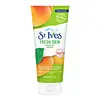What's inside
What's inside
 Key Ingredients
Key Ingredients

 Benefits
Benefits

 Concerns
Concerns

 Ingredients Side-by-side
Ingredients Side-by-side

Water
Skin ConditioningJuglans Regia Shell Powder
AbrasiveGlyceryl Stearate Se
EmulsifyingGlycerin
HumectantCetearyl Alcohol
EmollientZea Mays Kernel Meal
AbrasiveCetyl Alcohol
EmollientSodium Lauryl Sulfoacetate
CleansingCocamidopropyl Betaine
CleansingGlyceryl Stearate
EmollientPEG-100 Stearate
Cetyl Acetate
EmollientBenzyl Alcohol
PerfumingCeteareth-20
CleansingAcetylated Lanolin Alcohol
EmollientCarbomer
Emulsion StabilisingPolysorbate 60
EmulsifyingTriethanolamine
BufferingParfum
MaskingDisodium EDTA
Benzoic Acid
MaskingSorbic Acid
PreservativePrunus Armeniaca Fruit Extract
Skin ConditioningCI 77891
Cosmetic ColorantWater, Juglans Regia Shell Powder, Glyceryl Stearate Se, Glycerin, Cetearyl Alcohol, Zea Mays Kernel Meal, Cetyl Alcohol, Sodium Lauryl Sulfoacetate, Cocamidopropyl Betaine, Glyceryl Stearate, PEG-100 Stearate, Cetyl Acetate, Benzyl Alcohol, Ceteareth-20, Acetylated Lanolin Alcohol, Carbomer, Polysorbate 60, Triethanolamine, Parfum, Disodium EDTA, Benzoic Acid, Sorbic Acid, Prunus Armeniaca Fruit Extract, CI 77891
Water
Skin ConditioningAlumina
AbrasiveGlycerin
HumectantCetearyl Alcohol
EmollientGlycolic Acid
BufferingHydrated Silica
AbrasiveLimnanthes Alba Seed Oil
Skin ConditioningSqualane
EmollientGlyceryl Stearate
EmollientCetearyl Olivate
Sodium Hydroxide
BufferingSorbitan Olivate
EmulsifyingGarnet Powder
AbrasiveQuartz
AbrasiveAscorbic Acid
AntioxidantTerminalia Ferdinandiana Fruit Extract
AntioxidantZiziphus Jujuba Seed Extract
Skin ConditioningTerminalia Ferdinandiana Seed Oil
AntioxidantOlea Europaea Leaf Extract
PerfumingCarthamus Tinctorius Seed Oil
MaskingCitrus Aurantifolia Oil
CleansingCitrus Aurantium Dulcis Peel Oil
MaskingCitrus Limon Peel Oil
MaskingCitrus Nobilis Oil
MaskingLavandula Hybrida Oil
EmollientVetiveria Zizanoides Root Oil
MaskingButyrospermum Parkii Butter
Skin ConditioningGlyceryl Caprylate
EmollientSodium Stearoyl Glutamate
CleansingCitric Acid
BufferingPhenethyl Alcohol
MaskingXylitol
HumectantCaprylic Acid
CleansingCaprylhydroxamic Acid
Galactoarabinan
Decyl Glucoside
CleansingLevan
Skin ProtectingDehydroxanthan Gum
Emulsion StabilisingCaprylyl Glycol
EmollientCitral
PerfumingLimonene
PerfumingWater, Alumina, Glycerin, Cetearyl Alcohol, Glycolic Acid, Hydrated Silica, Limnanthes Alba Seed Oil, Squalane, Glyceryl Stearate, Cetearyl Olivate, Sodium Hydroxide, Sorbitan Olivate, Garnet Powder, Quartz, Ascorbic Acid, Terminalia Ferdinandiana Fruit Extract, Ziziphus Jujuba Seed Extract, Terminalia Ferdinandiana Seed Oil, Olea Europaea Leaf Extract, Carthamus Tinctorius Seed Oil, Citrus Aurantifolia Oil, Citrus Aurantium Dulcis Peel Oil, Citrus Limon Peel Oil, Citrus Nobilis Oil, Lavandula Hybrida Oil, Vetiveria Zizanoides Root Oil, Butyrospermum Parkii Butter, Glyceryl Caprylate, Sodium Stearoyl Glutamate, Citric Acid, Phenethyl Alcohol, Xylitol, Caprylic Acid, Caprylhydroxamic Acid, Galactoarabinan, Decyl Glucoside, Levan, Dehydroxanthan Gum, Caprylyl Glycol, Citral, Limonene
 Reviews
Reviews

Ingredients Explained
These ingredients are found in both products.
Ingredients higher up in an ingredient list are typically present in a larger amount.
Cetearyl alcohol is a mixture of two fatty alcohols: cetyl alcohol and stearyl alcohol. It is mainly used as an emulsifier. Emulsifiers help prevent the separation of oils and products. Due to its composition, it can also be used to thicken a product or help create foam.
Cetearyl alcohol is an emollient. Emollients help soothe and hydrate the skin by trapping moisture.
Studies show Cetearyl alcohol is non-toxic and non-irritating. The FDA allows products labeled "alcohol-free" to have fatty alcohols.
This ingredient is usually derived from plant oils such as palm, vegetable, or coconut oils. There is debate on whether this ingredient will cause acne.
Due to the fatty acid base, this ingredient may not be Malassezia folliculitis safe.
Learn more about Cetearyl AlcoholGlycerin is already naturally found in your skin. It helps moisturize and protect your skin.
A study from 2016 found glycerin to be more effective as a humectant than AHAs and hyaluronic acid.
As a humectant, it helps the skin stay hydrated by pulling moisture to your skin. The low molecular weight of glycerin allows it to pull moisture into the deeper layers of your skin.
Hydrated skin improves your skin barrier; Your skin barrier helps protect against irritants and bacteria.
Glycerin has also been found to have antimicrobial and antiviral properties. Due to these properties, glycerin is often used in wound and burn treatments.
In cosmetics, glycerin is usually derived from plants such as soybean or palm. However, it can also be sourced from animals, such as tallow or animal fat.
This ingredient is organic, colorless, odorless, and non-toxic.
Glycerin is the name for this ingredient in American English. British English uses Glycerol/Glycerine.
Learn more about GlycerinGlyceryl Stearate is a mix of glycerin and stearic acid.
It is used to stabilize the mixing of water and oil ingredients. By preventing these ingredients from separating, it can help elongate shelf life. It can also help thicken the product's texture.
As an emollient, it helps soften skin and supports barrier-replenishing ingredients.
In cosmetics, Glyceryl Stearate is often made from vegetable oils or synthetically produced.
This ingredient may not be fungal-acne safe
Fun fact: The human body also creates Glyceryl Stearate naturally.
Learn more about Glyceryl StearateWater. It's the most common cosmetic ingredient of all. You'll usually see it at the top of ingredient lists, meaning that it makes up the largest part of the product.
So why is it so popular? Water most often acts as a solvent - this means that it helps dissolve other ingredients into the formulation.
You'll also recognize water as that liquid we all need to stay alive. If you see this, drink a glass of water. Stay hydrated!
Learn more about Water